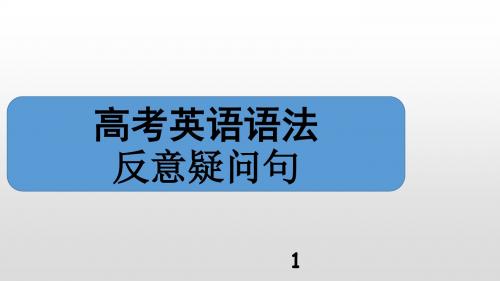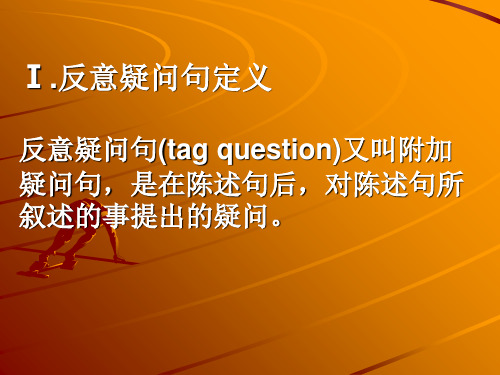完整反义疑问句PPT课件2016
合集下载
高考英语语法——反意疑问句(共11张PPT)

9
当陈述句部分含有主从复合句时,附加部分的代词和助动词 须与主句中的主谓保持一致。
You needn't do it since he has finished it, need you? It's the second time that you have sung that song, isn't it?
ome, shall we?
Let us go home, will you?
Open the door, will you?
5
need和dare既可以用作情态动词,又可以用作行为动词,所以在反意疑 问句中要准确判断其是情态动词还是行为动词。
He needn’t do it again, need he? He doesn’t need to do it again, does he? She dare say it, daren’t she? She doesn’t dare to say it, does she?
2
构成
The car is your father's, The girl doesn't sleep, The doctor can help you,
陈述句
isn't it? does she? can't he?
反意疑问句
be动词/情态动词/助动词 (not)+主语(代词)
3
前肯后否 前否后肯
He thinks that it will rain tomorrow, doesn't he? I think that it will rain tomorrow, won't it? They don't suppose that the film is moving, do they?
当陈述句部分含有主从复合句时,附加部分的代词和助动词 须与主句中的主谓保持一致。
You needn't do it since he has finished it, need you? It's the second time that you have sung that song, isn't it?
ome, shall we?
Let us go home, will you?
Open the door, will you?
5
need和dare既可以用作情态动词,又可以用作行为动词,所以在反意疑 问句中要准确判断其是情态动词还是行为动词。
He needn’t do it again, need he? He doesn’t need to do it again, does he? She dare say it, daren’t she? She doesn’t dare to say it, does she?
2
构成
The car is your father's, The girl doesn't sleep, The doctor can help you,
陈述句
isn't it? does she? can't he?
反意疑问句
be动词/情态动词/助动词 (not)+主语(代词)
3
前肯后否 前否后肯
He thinks that it will rain tomorrow, doesn't he? I think that it will rain tomorrow, won't it? They don't suppose that the film is moving, do they?
反意疑问句ppt课件

• Jack wasn’t playing soccer, _w__a_s _h_e___? • Their parents have gone to London,
__h_a_v_e_n_’_t t_h_e_y__? • I have never been to the park, __h_a_v_e_n’_t_I__? • You have a good friend, __d_o_n_’t_y_o_u___? • We had a meeting, __d_i_d_n_’t_w_e___?
Grammar: 反意疑问句
一、定义:
当我们陈述了一个事实,而又不是很 有把握,就可以在陈述句后加一个简 短问句,称为反意疑问句。它表示提 问人的看法,没有把握,需要对方证 实。反义疑问句由两部分组成:前一 部分是一个陈述句,后一部分是一个 简短的疑问句,两部分的人称时态应 保持一致。
二、结构:
结构一: 前肯,+ 后否 eg. She is a student, isn’t she?
结构二: 前否,+ 后肯 eg. She isn’t a student, is she?
三、反意疑问句的解答步骤
1. 判定(判断该用肯定还是否定); 2. 找动(找句子的助动词:be用be,动词原形do, 三单does,过去did,完成have); 3. 换代(将主语换为人称代词);
2. 一般动词(play, study, watch 等)句型:
现在 主语+play/plays…, don’t (doesn’t) + 主语? 过去 主语+played…, didn’t + 主语?
1 Your mother likes cooking ,_d__o_e_s_n_’t_s_h_e___? 2 He has an apple, __d_o_e_s_n_’_t _h_e____? 3 The plane took off an hour ago, __d_i_d_n_’t_i_t___? 4 He didn’t go to school late this morning,
反义疑问句最全PPT课件

3.陈述部分由neither… nor, either… or 连接的并列主语 时,疑问部分根据其实际逻辑意义而定。
Neither you nor I am engineer, are we?
4.陈述部分主语是指示代词或不定代词everything, that, nothing, this, 疑问部分主语用it。
(二)陈述部分有表示过去的时间状语,疑问部分的动词 就用一般过去时。(didn’t + 主语) She must have read the novel last week, didn’t she?
b 表示否定推测时,否定式通常不是must not,而是 can’t (cannot) He can’t have been to your home because he doesn't know your address, does he?
6.否定前缀不能视为否定词,其反意疑问句仍用否定形式。 It is impossible, isn’t it? He is not unkind to his classmates, is he?
7.当主句是由so引起的一个句子,而且译为“这么说来” 时,疑问部分的谓语形式(肯定或否定)应与主句保持一 致。 So you have seen the film, have you? So he has not been to Beijing, has he?
b. 带有定语从句,宾语从句的主从复合句,疑问部分谓 语根据主句的谓语而定 He is not the man who gave us a talk, is he? He said he wanted to visit Japan, didn’t he?
c. 上述部分主句是由谓语think, believe, expect, suppose, imagine等引导的宾语从句,疑问部分与宾语 从句相对应构成反意疑问句 I don't think he is bright, is he? We believe she can do it better, can't she?
完整反义疑问句课件

如果陈述句是肯定的,反义疑问句应该是否定的。
2 人称一致
陈述句和反义疑问句中的主语和动词人称要保持一致。,避免使用复杂的句子结构。
结束语
通过学习反义疑问句的结构和用法,我们可以更好地理解和运用这个表达方 式,提升我们的语言表达能力。
完整反义疑问句PPT课件
PPT介绍反义疑问句
什么是反义疑问句?
反义疑问句是指一种用于提问或表示疑问的句子结构,通常由一个陈述句和一个反义疑问句构成。
反义疑问句的结构
1
陈述句部分
包含陈述句的主谓宾结构
2
反义疑问句部分
由一个助动词和一个否定词构成
3
连接词
连接陈述句和反义疑问句的部分,常用的连接词包括but和yet
反义疑问句的语气和语调
语气
反义疑问句通常用于表示疑问、请求或强调某 种认可的语气。
语调
反义疑问句通常以升调结尾,以引起对方的回 答或注意。
反义疑问句的用法与例句
询问意见
这个计划听起来很好,不是吗?
表示认可
你很喜欢这部电影,对吗?
确认信息
你不会去参加聚会,对吗?
反义疑问句的注意事项
1 肯定陈述,否定反义疑问
2 人称一致
陈述句和反义疑问句中的主语和动词人称要保持一致。,避免使用复杂的句子结构。
结束语
通过学习反义疑问句的结构和用法,我们可以更好地理解和运用这个表达方 式,提升我们的语言表达能力。
完整反义疑问句PPT课件
PPT介绍反义疑问句
什么是反义疑问句?
反义疑问句是指一种用于提问或表示疑问的句子结构,通常由一个陈述句和一个反义疑问句构成。
反义疑问句的结构
1
陈述句部分
包含陈述句的主谓宾结构
2
反义疑问句部分
由一个助动词和一个否定词构成
3
连接词
连接陈述句和反义疑问句的部分,常用的连接词包括but和yet
反义疑问句的语气和语调
语气
反义疑问句通常用于表示疑问、请求或强调某 种认可的语气。
语调
反义疑问句通常以升调结尾,以引起对方的回 答或注意。
反义疑问句的用法与例句
询问意见
这个计划听起来很好,不是吗?
表示认可
你很喜欢这部电影,对吗?
确认信息
你不会去参加聚会,对吗?
反义疑问句的注意事项
1 肯定陈述,否定反义疑问
反义疑问句详细讲解课件(PPT27张)

I don’t believe he has finished his work.
7.当陈述部分的主句是I think (expect, believe)等结构时,反 意疑问句的附加部分则往往与从 句中的主语和谓语动词保持对应 关系,但要注意否定的转移。 例如:
I think he’s funny, isn’t he? I don’t believe she likes my
You must have seen the film last week, didn’t you?
6. 当陈述部分是I am…时,反意疑 问句部分通常要用aren’t I;如陈述 句部分的主语是I am not时,反意疑 问句部分通常要用am I。 例如:
1)I am a teacher, aren’t I?
Ⅰ.反意疑问句定义
反意疑问句(tag question)又叫附加 疑问句,是在陈述句后,对陈述句所 叙述的事提出的疑问。
Ⅱ.基本结构:
陈述句+逗号+简短的一般疑问句?
遵循前肯定后否定前否后肯式的原则
①前肯后否式。例如:
You are all students, aren’t you﹖
②前否后肯式。例如:
Let’s have a rest, shall we? 以let us开头的祈使句,不包括 说话人在内,因此反意疑问句的 附加部分用will you。例如:
Let us stop now, will you?
Ⅳ. 反意疑问句的回答 “ 根据事实回答”
对反意疑问句的回答,无论问题的提法如何,如果 事实是肯定的,就用yes,事实是否定的,就要用no。 要特别注意陈述句部分是否定结构,反意疑问句部分 用肯定式提问时,回答yes或no与汉语正好相反。这 种省略回答的yes要译成“不”,no要译成“是”。
7.当陈述部分的主句是I think (expect, believe)等结构时,反 意疑问句的附加部分则往往与从 句中的主语和谓语动词保持对应 关系,但要注意否定的转移。 例如:
I think he’s funny, isn’t he? I don’t believe she likes my
You must have seen the film last week, didn’t you?
6. 当陈述部分是I am…时,反意疑 问句部分通常要用aren’t I;如陈述 句部分的主语是I am not时,反意疑 问句部分通常要用am I。 例如:
1)I am a teacher, aren’t I?
Ⅰ.反意疑问句定义
反意疑问句(tag question)又叫附加 疑问句,是在陈述句后,对陈述句所 叙述的事提出的疑问。
Ⅱ.基本结构:
陈述句+逗号+简短的一般疑问句?
遵循前肯定后否定前否后肯式的原则
①前肯后否式。例如:
You are all students, aren’t you﹖
②前否后肯式。例如:
Let’s have a rest, shall we? 以let us开头的祈使句,不包括 说话人在内,因此反意疑问句的 附加部分用will you。例如:
Let us stop now, will you?
Ⅳ. 反意疑问句的回答 “ 根据事实回答”
对反意疑问句的回答,无论问题的提法如何,如果 事实是肯定的,就用yes,事实是否定的,就要用no。 要特别注意陈述句部分是否定结构,反意疑问句部分 用肯定式提问时,回答yes或no与汉语正好相反。这 种省略回答的yes要译成“不”,no要译成“是”。
完整反义疑问句课件

04
反义疑问句的回答
肯定回答
要点一
肯定回答时,通常使用“Yes”来 回答反义疑问句,并重复…
You like apples, don’t you? 回答:Yes, I do.
要点二
如果对反义疑问句中的否定部分 进行强调,可以使用“Yes…
You didn’t go to the party, did you? 回答:Yes, I did.
详细描述
反义疑问句是一种常见的语法结构,通常用于表达说话者的 态度、观点或对某件事情的疑问。它的特点是前半部分是一 个肯定或否定的陈述句,而后半部分则通过疑问的形式表达 相反的意思。
类型
总结词
反义疑问句可以分为两种类型,即标准反义疑问句和非标准反义疑问句。
详细描述
标准反义疑问句的前半部分是一个肯定句,后半部分是一个否定疑问句;或者 前半部分是一个否定句,后半部分是一个肯定疑问句。而非标准反义疑问句则 不遵循这一规则,前后两部分没有明显的相反意思。
总结词
表示某些特殊情况或特殊用法,需要特 别注意。
VS
详细描述
在某些特殊情况下,反义疑问句的用法可 能会发生变化。例如,当陈述句为祈使句 时,反义疑问句通常会省略主语;当陈述 句为感叹句时,反义疑问句通常会省略疑 问词。此外,还有一些特殊的反义疑问句 结构,如“他不是学生吗?”等,需要特 别注意其用法和含义。
否定回答
要点一
否定回答时,可以使用“No”来 回答反义疑问句,并重复疑…
You don’t like coffee, do you? 回答:No, I don’t.
要点二
如果对反义疑问句中的肯定部分 进行强调,可以使用“No,…
You went to the concert, didn’t you? 回答:No, I didn’t.
反义疑问句(共14张PPT)全
二、前否+后肯
1.She wasn’t ill last week, was she ? 2.It doesn’t often rain here, does it? 3.Tom won’t go to Shanghai next year,
will he ?
特殊用法1—祈使句的反义疑问句
1、肯定祈使句的反意疑问句,疑问部分用will you或won’t you,否定祈使句则用will you ? 如: Don't do that again, will you? Go with me, will you / won't you?
13、He who seize the right moment, is the right man.谁把握机遇,谁就心想事成。2024/10/172024/10/172024/10/172024/10/1710/17/2024 +14、谁要是自己还没有发展培养和教育好,他就不能发展培养和教育别人。2024年10月17日星期四2024/10/172024/10/172024/10/17 +15、一年之计,莫如树谷;十年之计,莫如树木;终身之计,莫如树人。2024年10月2024/10/172024/10/172024/10/1710/17/2024 +16、教学的目的是培养学生自己学习,自己研究,用自己的头脑来想,用自己的眼睛看,用自己的手来做这种精神。2024/10/172024/10/17October 17, 2024 +17、儿童是中心,教育的措施便围绕他们而组织起来。2024/10/172024/10/172024/10/172024/10/17
一 、前肯+后否 含be动词
1.He is a doctor, isn’t he? 2.I am Chinese, aren’t I?
高中英语语法反义疑问句-PPT
It is a fine day. Let’s go fishing, _sh_a_l_l_w_e_? Let us do this job,_w_i_ll_y_o_u_?
Turn on thewrialdl iyoo,u__/w__o_n_’t_?you
24
16)陈述部分是“there be”结构 时:
6
2)陈述部分用 no, nothing, nobody, never, few, seldom, hardly, rarely, little等否定含义 的词时,疑问部分用肯定含义。
The Swede made no answer, did he / she? Some plants never blown (开花 ), do they ?
He would rather read it ten times than recite it, wouldn't he?
13
8)陈述部分有You'd like to + v. 疑问部分用wouldn't +主语。
You’d like to go with me, wouldn't you?
14
9)must表示“推测”时,如何确
定反意疑问句?
He must be a doctor, isn't he?
He must like physics, doesn't
he?
You must have studied English,
haven't you?
He must have finished it
17)否定前缀不能视为否定词, 其反意疑问句仍用否定形式。
It is impossible, isn't it?
反义疑问句详细讲解课件(PPT27张)
2) have to表示“不得不,必须”之意 时,附加问句的谓语应用助动词do.
Kate has to help her mother at home,doesn’t she?
3) have表示“吃,喝,玩,度过”等意 思时,其附加问句的谓语应用助动词do.
They had a good time in Beijing ,didn’t they?
Ⅰ.反意疑问句定义
反意疑问句(tag question)又叫附加 疑问句,是在陈述句后,对陈述句所 叙述的事提出的疑问。
Ⅱ.基本结构:
陈述句+逗号+简短的一般疑问句?
遵循前肯定后否定前否后肯式的原则
①前肯后否式。例如:
You are all students, aren’t you﹖
②前否后肯式。例如:
[误] Tom can speak Chinese well, can’t Tom﹖
[正] Tom can speak Chinese well, can’t he﹖
一般现在时:
Lily likes going shopping, d_o_e_s_n__’t_she? They aren’t students, __a_r_e___
You must have seen the film last week, didn’t you?
6. 当陈述部分是I am…时,反意疑 问句部分通常要用aren’t I;如陈述 句部分的主语是I am not时,反意疑 问句部分通常要用am I。 例如:
1)I am a teacher, aren’t I?
The End
They must come on time,needn’t they?
2)must表示推测,“一定,想必”之意,附加问 句的谓语动词的确定应根据must后面的动词。
Kate has to help her mother at home,doesn’t she?
3) have表示“吃,喝,玩,度过”等意 思时,其附加问句的谓语应用助动词do.
They had a good time in Beijing ,didn’t they?
Ⅰ.反意疑问句定义
反意疑问句(tag question)又叫附加 疑问句,是在陈述句后,对陈述句所 叙述的事提出的疑问。
Ⅱ.基本结构:
陈述句+逗号+简短的一般疑问句?
遵循前肯定后否定前否后肯式的原则
①前肯后否式。例如:
You are all students, aren’t you﹖
②前否后肯式。例如:
[误] Tom can speak Chinese well, can’t Tom﹖
[正] Tom can speak Chinese well, can’t he﹖
一般现在时:
Lily likes going shopping, d_o_e_s_n__’t_she? They aren’t students, __a_r_e___
You must have seen the film last week, didn’t you?
6. 当陈述部分是I am…时,反意疑 问句部分通常要用aren’t I;如陈述 句部分的主语是I am not时,反意疑 问句部分通常要用am I。 例如:
1)I am a teacher, aren’t I?
The End
They must come on time,needn’t they?
2)must表示推测,“一定,想必”之意,附加问 句的谓语动词的确定应根据must后面的动词。
《反义疑问句》课件
提供一些实际例子,引导听众分析和理解反义疑问句的适用场景。
2
练习及反馈
设计题目供听众练习反义疑问句的运用,并提供实时反馈和解析。
结语
反义疑问句的重要性和使用 价值
总结反义疑问句在语言表达中的重要性和应 用价值。
希望大家能够运用反义疑问 句更好地沟通交流。
什么是反义 疑问句?
解释反义疑问句的 定义和作用,引起 听众的兴趣和好奇。
反义疑问句 的组成结构
解析反义疑问句的 构成要素,加深理 解和记忆。
反义疑问句 的附加疑问 部分形式
介绍反义疑问句中 常见的附加疑问部 分形式,提供实例 加深印象。
反义疑问句 的特点与注 意事项
探讨反义疑问句的 独特特点和注意事 项,帮助听众正确 运用。
《反义疑问句》PPT课件
反义疑问句PPT课件,通过精心设计的幻灯片,详细阐述反义疑问句的基本 语法与使用场景,帮助大家更好地运用反义疑问句进行沟通交流。
概述
基本语法与特点
掌握反义疑问句的基本语法和特点,提高语 言表达的灵活性。
使用场景
了解反义疑问句的应用场景,拓宽交流和表 达的方式。
反义疑问句的基本语法与特点
反义疑问句的使用场景
常见的反义疑问句应用 场景
反义疑问句在交流中的 作用
列举常见的日常对话和情境, 逐一讲解如何使用反义疑问句。
阐述反义疑问句在有效沟通中 的作用和价值,引发思考和一些技 巧和注意事项,提高语言表达 的准确性。
练习与实践
1
反义疑问句实例分析
- 1、下载文档前请自行甄别文档内容的完整性,平台不提供额外的编辑、内容补充、找答案等附加服务。
- 2、"仅部分预览"的文档,不可在线预览部分如存在完整性等问题,可反馈申请退款(可完整预览的文档不适用该条件!)。
- 3、如文档侵犯您的权益,请联系客服反馈,我们会尽快为您处理(人工客服工作时间:9:00-18:30)。
①They said that you had finished your work, didn’t they? (不用hadn’t you)
②Kate told you that she would go there, didn’t she? (不用wouldn’t she?)
九、陈述部分的主语为指物的不定代词something, anything, nothing, everything时,问句部分的主语用it。 陈述部分的主语为指人的不定代词
She must stay at home, needn’t she? 2、当mustn’t表“禁止”时,疑问部分用must。 如:
You mustn’t play with fire, must you? 3、当must表“一定;想必”等推测意义时,问 句部分的助动词应和must后面的助动词相呼应。 如:
②Nothing has happened to them, has it? 如:
③Someone has taken the seat, hasn’t he? ④Everyone has done their best in the game,
haven’t they?
十一、陈述部分肯定祈使句时,问句部分一般 用will you?形式表示请求,用won’t you?形式 表示委婉请求或邀请。陈述部分为否定祈使句 时,问句部分一般用will you?形式。如:
①They all think that English is very important, don’t they? (不用isn’t it?)
②He didn’t think that the news was true, did he? (不用wasn’t/ was it?)
八、反意疑问句的陈述部分为主语 +said( told, reported, asked……) + that从句 时,问句部分的动词和主语与陈述部分的主句 动词和主语保持一致。如:
十三、陈述部分用had better +原形动词表示建 议时,问句部分用hadn’t +主语?形式。
①You’d better tell him about the matter,
hadn’t you? ②We had better do it by ourselves,
hadn’t we?
十四、陈述部分用used to +主语时,问句部分用 didn’t + 主语?或usedn’t +主语?形式。
②Skating is your favorite sport, isn't it?
2、反意疑问句的陈述部分为I(We) don’t think(believe, suppose, consider)+ that从句时, 从句为否定意义,问句部分的动词和主语仍与that 从句保持一致且用肯定式。如:
①I don’t think that you can do it, can you? (不用do I?)
②The man is dishonest, isn’t he?
③It is impossible to learn English without remembering more words, isn’t it?
五、反意疑问句的陈述部分带有little, few, never, hardly, seldom等否定意义的词时,问句部分用肯 定式。如: ①She never tells a lie, does she? ②He was seldom late, was he?(不用wasn’t
①Do sit down, won’t you?/ will you? ②You feed the bird today, will you? ③Please open the window, will
you?(won’t you?)
④Don’t make any noise, will you?
十二、陈述部分为There (Here) + be + 主语时, 问句部分用动词+there(here)?形式。如:
②We don’t believe that the news is true, is it? (不用do we?)
3、反意疑问句的陈述部分为非第一人称主语+ think(believe, suppose, consider) + that从句 时,问句部分的动词和主语与陈述部分的主句动 词和主语保持一致。如:
②Where we will build the dam has not
been decided yet, has it? (不用won’t we?)
十七、陈述部分的主语为动名词或不定 式时,问句的主语用it代替。如:
①To do one good deed is easy for a person, isn't it?
Let me have a try, shall I?(will you?)
陈述部分为Let us……时,问句部分习惯上用will you? 形式。如:
Let us stop to rest, will you?
陈述部分为Let’s……时,问句部分习惯上用shall we? 形式。如:
Let’s go home together, shall we?
1.陈述部分肯定式 + 疑问部分 否定式
She works here, doesn’t she?
She was ill yesterday, wasn’t she?
2.陈述部分否定式 + 疑问部分 肯定式
You didn’t go, did you?
He can’t ride a bike, can he?
①There are two cakes on the plate, aren’t there?
②Here is a story about Mark Twain, isn’t here?
2)陈述部分的谓语是wish,疑 问部分要用may +主语
பைடு நூலகம்I wish to have a word with you, may I?
反意疑问句对应规则24条
反意疑问句是英语四大问句之一,它是由 一个陈述句加上一个短问句而构成的。 反意疑问句的基本构成形式是: 陈述句+动词(肯定或否定)+主语?如:
①She often has lunch at school, doesn’t she?
②You don’t like sports, do you? 使用反意疑问句要注意以下若干对应规则:
somebody(someone), anybody(anyone), nobody(no one), everybody(everyone)时,问句部分的主语用he 或 they,这时问句动词的数应和he或 they一致。如:
①Something is wrong with the computer, isn’t it?
It must be delicious, isn’t it?
They must be playing basketball, aren’t they?
十六、陈述部分的主语为从句时,问句部分 的主语一般用it代替,如:
①What he said is true, isn't it? (不用 didn’t he?)
he?)
六、反意疑问句的陈述部分为I am……时,问句 部分习惯上用aren’t I?表示。如: I am a very honest man, aren’t I?
I’m as tall as your sister, aren’t I?
I am a student, aren’t I ?
十、陈述部分为Let me……时,问句部分习惯上用shall I? 或will you?形式。如:
一、 反意疑问句中问句部分的动词与陈述部分的动词在 语气上成相反的对应关系,即:
肯定+否定? 否定+肯定?如: ①You can’t do it, can you? ②They are very late for the meeting, aren’t they?
19)否定前缀不能视为否定词, 其反意疑问句仍用否定形式。
①He used to live in the country, didn’t he?/usedn’t he?
②They used to be good friends, didn’t they?/usedn’t they?
十五、陈述部分含有时 1、当must表“必须”时,疑问部分用needn’t。 如:
It is impossible, isn't it?
He is not unkind to his classmates, is he?
四、 反意疑问句的陈述部分含有由un-, im-, in-, dis-, 等否定意义的前缀构成的词语时,陈述部分 要视为肯定含义,问句部分用否定形式。如:
①Your father is unhappy, isn’t he?
②Kate told you that she would go there, didn’t she? (不用wouldn’t she?)
九、陈述部分的主语为指物的不定代词something, anything, nothing, everything时,问句部分的主语用it。 陈述部分的主语为指人的不定代词
She must stay at home, needn’t she? 2、当mustn’t表“禁止”时,疑问部分用must。 如:
You mustn’t play with fire, must you? 3、当must表“一定;想必”等推测意义时,问 句部分的助动词应和must后面的助动词相呼应。 如:
②Nothing has happened to them, has it? 如:
③Someone has taken the seat, hasn’t he? ④Everyone has done their best in the game,
haven’t they?
十一、陈述部分肯定祈使句时,问句部分一般 用will you?形式表示请求,用won’t you?形式 表示委婉请求或邀请。陈述部分为否定祈使句 时,问句部分一般用will you?形式。如:
①They all think that English is very important, don’t they? (不用isn’t it?)
②He didn’t think that the news was true, did he? (不用wasn’t/ was it?)
八、反意疑问句的陈述部分为主语 +said( told, reported, asked……) + that从句 时,问句部分的动词和主语与陈述部分的主句 动词和主语保持一致。如:
十三、陈述部分用had better +原形动词表示建 议时,问句部分用hadn’t +主语?形式。
①You’d better tell him about the matter,
hadn’t you? ②We had better do it by ourselves,
hadn’t we?
十四、陈述部分用used to +主语时,问句部分用 didn’t + 主语?或usedn’t +主语?形式。
②Skating is your favorite sport, isn't it?
2、反意疑问句的陈述部分为I(We) don’t think(believe, suppose, consider)+ that从句时, 从句为否定意义,问句部分的动词和主语仍与that 从句保持一致且用肯定式。如:
①I don’t think that you can do it, can you? (不用do I?)
②The man is dishonest, isn’t he?
③It is impossible to learn English without remembering more words, isn’t it?
五、反意疑问句的陈述部分带有little, few, never, hardly, seldom等否定意义的词时,问句部分用肯 定式。如: ①She never tells a lie, does she? ②He was seldom late, was he?(不用wasn’t
①Do sit down, won’t you?/ will you? ②You feed the bird today, will you? ③Please open the window, will
you?(won’t you?)
④Don’t make any noise, will you?
十二、陈述部分为There (Here) + be + 主语时, 问句部分用动词+there(here)?形式。如:
②We don’t believe that the news is true, is it? (不用do we?)
3、反意疑问句的陈述部分为非第一人称主语+ think(believe, suppose, consider) + that从句 时,问句部分的动词和主语与陈述部分的主句动 词和主语保持一致。如:
②Where we will build the dam has not
been decided yet, has it? (不用won’t we?)
十七、陈述部分的主语为动名词或不定 式时,问句的主语用it代替。如:
①To do one good deed is easy for a person, isn't it?
Let me have a try, shall I?(will you?)
陈述部分为Let us……时,问句部分习惯上用will you? 形式。如:
Let us stop to rest, will you?
陈述部分为Let’s……时,问句部分习惯上用shall we? 形式。如:
Let’s go home together, shall we?
1.陈述部分肯定式 + 疑问部分 否定式
She works here, doesn’t she?
She was ill yesterday, wasn’t she?
2.陈述部分否定式 + 疑问部分 肯定式
You didn’t go, did you?
He can’t ride a bike, can he?
①There are two cakes on the plate, aren’t there?
②Here is a story about Mark Twain, isn’t here?
2)陈述部分的谓语是wish,疑 问部分要用may +主语
பைடு நூலகம்I wish to have a word with you, may I?
反意疑问句对应规则24条
反意疑问句是英语四大问句之一,它是由 一个陈述句加上一个短问句而构成的。 反意疑问句的基本构成形式是: 陈述句+动词(肯定或否定)+主语?如:
①She often has lunch at school, doesn’t she?
②You don’t like sports, do you? 使用反意疑问句要注意以下若干对应规则:
somebody(someone), anybody(anyone), nobody(no one), everybody(everyone)时,问句部分的主语用he 或 they,这时问句动词的数应和he或 they一致。如:
①Something is wrong with the computer, isn’t it?
It must be delicious, isn’t it?
They must be playing basketball, aren’t they?
十六、陈述部分的主语为从句时,问句部分 的主语一般用it代替,如:
①What he said is true, isn't it? (不用 didn’t he?)
he?)
六、反意疑问句的陈述部分为I am……时,问句 部分习惯上用aren’t I?表示。如: I am a very honest man, aren’t I?
I’m as tall as your sister, aren’t I?
I am a student, aren’t I ?
十、陈述部分为Let me……时,问句部分习惯上用shall I? 或will you?形式。如:
一、 反意疑问句中问句部分的动词与陈述部分的动词在 语气上成相反的对应关系,即:
肯定+否定? 否定+肯定?如: ①You can’t do it, can you? ②They are very late for the meeting, aren’t they?
19)否定前缀不能视为否定词, 其反意疑问句仍用否定形式。
①He used to live in the country, didn’t he?/usedn’t he?
②They used to be good friends, didn’t they?/usedn’t they?
十五、陈述部分含有时 1、当must表“必须”时,疑问部分用needn’t。 如:
It is impossible, isn't it?
He is not unkind to his classmates, is he?
四、 反意疑问句的陈述部分含有由un-, im-, in-, dis-, 等否定意义的前缀构成的词语时,陈述部分 要视为肯定含义,问句部分用否定形式。如:
①Your father is unhappy, isn’t he?
